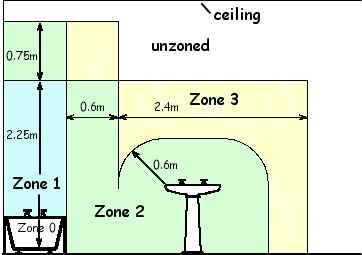Using electrical equipment in the bathroom (old regulations)
NOTE: the 17th Edition of the IEE Wiring Regulations changed the regulation with effect from 30th June 2008 - see our new page for details.see Electrical Building Regs 2005
the zones - equipment for bathrooms - use of equipment
Using electrical equipment in bath or shower rooms has always needed care to ensure safety. Now the IEE Wiring Regulations (16th Edition) have identified particular zones within the bathroom to indicate what type of electrical equipment that can be installed.
This page is given for guidance only, always refer to the current IEE Wiring Regulations or a qualified electrician to ensure that you are guided by the latest regulations/code of practice.
The zones
The zones are identified from 0 to 3, with 0 being the wettest.

- Zone 0
- The interior of the bath or shower which can hold water.
- Zone 1
- The area directly above zone 0 limited vertically to 2.25m above the bottom of the bath or shower.
- Zone 2
- The area beyond zones 0 and 1, 0.6m horizontally and up to 2.25m vertically. Zone 2 also included any window with a sill next to the bath.
- Zone 3
- The area beyond zones 2, 2.4m horizontally and up to 2.25m vertically.
- Where ceiling heights exceed 2.25m, the zones are effectively up to 3m - beyond 3m, the walls are 'out of scope'.
- Basins are not covered, however they are usually considered to be Zone 2.
- Providing that the space under the bath cannot be accessed without using tools (i.e. screwdriver etc), that space is considered to be 'out of scope'.
Equipment for bathrooms
Electrical equipment may be identified as having a certain level of mechanical and moisture protection, these are quoted as 'Ingress Protection' (or IP) numbers - such as 'IPXY', where X and Y are numbers, the X showing the level of mechanical protection and Y showing the level of moisture protection - in both cases, the higher the number, the better the protection. If a piece of equipment does not have an IP number, it must not be used in zones 0, 1 or 2 (or elsewhere having a wet/damp environment).
Typical electrical items which are marked with IP numbers include:- Extractor fans
- Lighting
- Heaters
- Electrical shower units
- Shower pumps
Shaver power points are not IP rated, however, if they comply with BS EN 60742 Chapter 2, Section 1, they can be located in zone 2 (or beyond) providing they are unlikely be be the subject of direct spray from any shower.
As well as IP numbers, items may be classed as PELV or SELV.
- Protective Extra-Low Voltage (PELV) - As the name suggests, the item uses low voltage but it is connected to earth.
- Separated Extra-Low Voltage (SELV) - Again a low voltage system but the output is isolated from the input.
Standard electrical wall fittings (such as wall sockets, flexible cord outlets and fused switches etc) are not IP rated so cannot be installed within zones 0, 1 or 2. No standard socket outlets are allowed anywhere in the bathroom.
Use of Equipment
Any electrical item approved for use in a zone may be used in another zone with a higher number, but not in a lower number zone.
- Zone 0
- Requires electrical products to low voltage (max. 12 volts) and be IPX7 (the mechanical protection is unimportant).
- Zone 1
- Requires electrical products to be IPX4 or better, or SELV with the transformer located in zone 3 or beyond. If the fitting is 240v, a 30mA RCD must be used to protect the circuit.
- Zone 2
- Requires electrical products to be IPX4 or better, or SELV with the transformer located in zone 3 or beyond.
- Zone 3
- The regulations do not specify any IP number for zone 3, however reference should be made to the manufacturers data in case it indicates any exclusion. Portable electrical equipment is not permitted other than that using a SELV or shaver unit.
- Beyond zone 3
- When the size of bathroom extends beyond zone 3, portable equipment is allowed, however they should be positioned such that that their flex length does not enable them to be used in zone 3.
